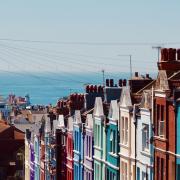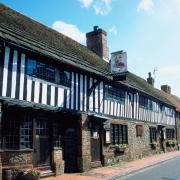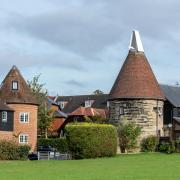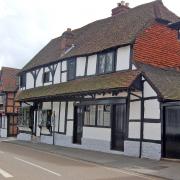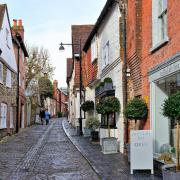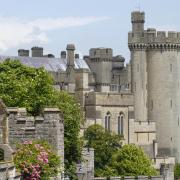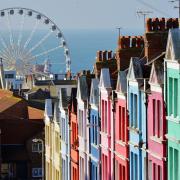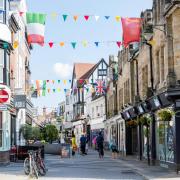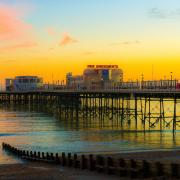Solution for the ‘Enigma’ piece by Tony Ward in the Sussex Life February issue
***
Enigma
From Sussex school to wartime hut,
an enigma to solve an enigma,
a gentle giant, eccentric ‘Prof’,
but a colossus that begat a new world.
His was no artificial intelligence, no mind in the machine.
“Action this day”,
bombes to save lives not take away.
And now, honoured for seventy year secrets,
the enigma remains.
We are his midnight comrades, inheritors –
the second generation
feeding humming monsters through air-chilled nights,
the third generation
student hackers turned code-crackers,
and the next company of heroes,
teenage minds locked in Mortal Kombat, bedroom warriors.
Torch bearers for the long-distance runner, but a marathon cut short
by the apple of forbidden love.
Another age, remorse, regret.
A Briton of Distinction, statues, memorials,
but you deserved so much better.
--------------------------------------------------
Solution - Alan Turing - World War II codebreaker, father of computer science and Artificial Intelligence
Alan Mathison Turing, OBE, FRS was born in Maida Vale, London in 1912 while his father was on leave from the Indian Civil Service. During Turing’s childhood years his parents travelled between Hastings and India. He attended St. Michael’s, a day school in St. Leonards-on-Sea from the ages of six to thirteen. His headmistress recognised his mathematical talent immediately. His education continued at Sherborne in Dorset, King’s College, Cambridge, and Princeton, before returning to Cambridge. During World War II he worked at the Government Code and Cypher School (GCCS), the forerunner of the present GCHQ, at Bletchley Park. He was head of Hut 8, the section responsible for cracking German naval codes and particularly their Enigma machine. Like many geniuses, Turing was a bit of an eccentric, known to his colleagues as ‘Prof’. In June each year, to combat hay fever he cycled to work wearing a gas mask, getting off his faulty bicycle at carefully counted intervals to adjust the chain before it came off. He never had it mended.
Bombes (not a mis-spelling) were the electromechanical machines that Turing developed in 1940 to crack the Enigma codes. His team had considerable success and significantly reduced shipping losses, but despite this were frustrated by lack of funds. Eventually they wrote directly to Winston Churchill, who fired off an immediate memo: “ACTION THIS DAY. Make sure they have all they want on extreme priority and report to me that this has been done”. There were no more resource problems. By the end of the war over two hundred bombes were in use. Additionally, in 1942, although Turing was not directly involved, some of his techniques fed into that of another team, Tommy Flowers’ work in developing Colossus. This was one of the world’s first programmable digital electronic computers. This further accelerated Bletchley’s code-cracking. It is widely accepted that Turing’s contribution shortened the War by two years. In 1945 he was awarded the OBE by King George VI “for wartime services”, the nature of which however were kept secret. His papers setting out the mathematical processes underlying his code-cracking methods continued to be of such value to GCHQ that they were not de-classified until April 2012.
After the war he refined his ideas on a ‘Universal Machine’ and in February 1946 presented a paper with the first detailed design of a stored-program computer. This launched the development of the first generation of computers around the world. That done, he then turned his attention to the possibility of Artificial Intelligence, devising what we now know as ‘The Turing Test’, a form of which is still used on the Internet today. This controversially argues that if a competent expert conversing with a remote computer, for example in a foreign language or in playing chess against it, cannot tell it from a human being then the computer is “intelligent”.
The next generations of computers replaced valves by transistors then by integrated circuits (“chips”) which power our present-day laptops, ipads, and iphones. Vast air-conditioned computer rooms housing humming cabinets as tall as their human operators, running day and night, came and went. Elementary computer programs, laboriously entered as strings of noughts and ones (binary), developed first into systems underpinning most functions of business, government and industry, and now into the ‘apps’ on our mobile phones. Computer games and the Internet brought Turing’s now truly ‘Universal Machines’ into our homes. World War II battles can now be enacted bloodlessly in games like ‘Company of Heroes’ and fighting skills honed in ‘Mortal Kombat’. GCHQ now even uses an on-line code-breaking test as a recruiting tool to attract talented ‘hackers’ to work for them.
Sadly, Turing did not live to see any of this. In 1952, he pleaded guilty to committing a then criminal act of homosexuality. Given a choice between imprisonment and ‘chemical castration’, he chose the latter. His security clearance was removed, he was no longer able to continue with government work here and was denied entry into the United States. Although it was said that Turing had suffered the side-effects of his chemical castration ‘with good humour’, it was assumed that he had decided to end his life. He had always been intrigued by the ambiguity of the poisoned apple in ‘Snow White and the Seven Dwarfs’. It is commonly accepted that he chose to inject his regular bedtime apple with cyanide, ironically the poison also used by old enemies, among them Adolf Hitler, Eva Brown, Rommel, and Himmler. On 8th June 1954, his cleaner found him dead, two weeks before his 42nd birthday, a half-eaten apple beside his bed. Although the apple itself was not tested for cyanide, the post-mortem revealed cyanide poisoning as the cause of death and so this became the suspect, although other theories suggest that it may have been a terrible accident due to his careless handling of a cyanide-using apparatus with which he was experimenting.
Over the years, and particularly since 2009, there has been growing remorse about Turing’s “appalling” treatment. Although the clock cannot be put back and although he was dealt with under the law of the time, on 10th September 1979 the then Prime Minister, Gordon Brown, released a statement on behalf of the Government apologising for his treatment – “We’re sorry, you deserved so much better”. The summer of 2013 saw this taken further by the introduction into the House of Lords of a Bill to give Turing a statutory pardon. The high-profile campaign was supported by tens of thousands of people, including Prof Stephen Hawking. As a result, in December 2013, Turing was granted a pardon by the Queen under the Royal Prerogative of Mercy, a rare occurrence, usually only granted at the request of a family member.
Turing is remembered around the world by blue plaques, statues, scholarship programmes, and the naming of University buildings, lecture and computer rooms. Established in 1966, the annual Turing Award is considered to be the computing profession’s equivalent to the Nobel Prize.
There have also been commemorative stamps (‘Britons of Distinction’), plays, films, TV programmes, an (erroneous) assumption that his manner of death was the inspiration for the Apple Computer logo (an apple with a bite taken out of it), and on the centenary of his death in 2012 even an ‘Alan Turing’ edition of Monopoly. A particularly appropriate tribute was organised in Manchester. Alan Turing was a talented long-distance runner, occasionally running the 40 miles from Bletchley to London for meetings. He was up to world-class marathon standards. On the evening of 23 June 2012, the exact centenary of his birth, the London 2012 Olympic Torch flame was passed in front of Turing’s statue in Sackville gardens. The statue shows him seated on a bench, an apple in his hand.
***
Sources
Relevant websites: found by searches for ‘Alan Turing’, ‘Bletchley Park’, ‘GCHQ’, ‘Computer Games’, ‘World Wide Web’, ‘Poison victims’, ‘Apple company logo’, ‘Early computer developments’, ‘Artificial Intelligence’, ‘The Turing Test’, ‘The Turing Award’.
Plays, films and documentaries: ‘Breaking the Code’ by Hugh Whitemore (1986); ‘Dangerous Knowledge’, BBC documentary (2008); ‘Britain’s Greatest Codebreaker’, Channel 4 (November 2011)
Postage stamps featuring Alan Turing: Saint Vincent and the Grenadines, ‘Greatest achievements of the 20th Century set’ (13 March 2000); Royal Mail, ‘Britons of Distinction series’ (February 2012).
Statues (UK): University of Surrey in Guildford; Bletchley Park; Sackville Park, Manchester; University of Edinburgh.
Locations of some buildings and rooms dedicated to Alan Turing (UK): University of Surrey in Guildford; King’s College, Cambridge; Bangor University in Wales; Keele University; The University of Manchester; The Open University; Oxford Brookes University.
Books (just an unusual one from several): ‘Cryptonomicon’, a novel by Neal Stephenson (1999)
Article (just a ‘different’ one from many): ‘The Guardian’s “My Hero” series’, choice of the writer Alan Garner (2011)
News reports upon the granting of the royal pardon, for example: ‘Codebreaker Turing is given posthumous royal pardon’, Caroline Davies, (The Guardian, front page, 24 December 2013)



